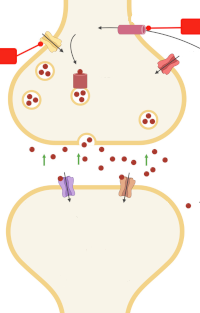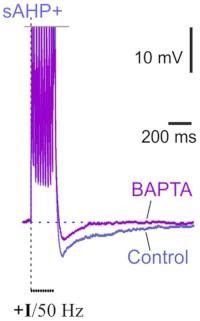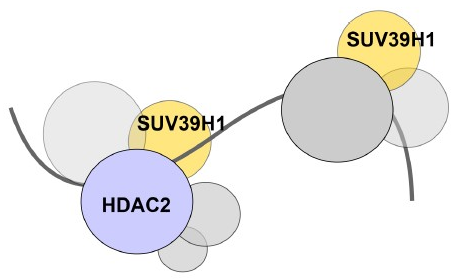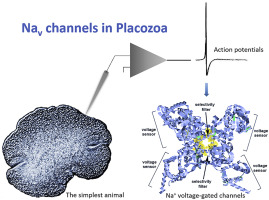Molecular biology
-
Hippocampal hyperglutamatergic signaling matters: Early targeting glutamate neurotransmission as a preventive strategy in Alzheimer's disease

Employees from the Laboratory of Functional Biochemistry of Nervous System highlight a remarkable study in the current issue of the Journal of Neurochemistry in which Hascup and coworkers provide novel data showing that riluzole, an anti‐glutamatergic drug, may be a promising early intervention strategy for Alzheimer's disease (AD), aimed at restoring glutamate neurotransmission prior to amyloid beta (Aβ) plaque accumulation and cognitive decline. The mice APP/PS1, a model of AD, initially are cognitively normal but have elevated glutamate release in the hippocampus at 2–4 months of age. They begin showing cognitive decline and Aβ plaque accumulation at approximately 6–8 months of age, and show obvious AD neuropathology and cognitive impairment at 10–12 months. The riluzole treatment over 4 months (at 2–6 months of age) targeting early changes in glutamatergic neurotransmission prevents cognitive decline observed at 12 months of age and restores glutamatergic neurotransmission. This is one of the most convincing preclinical evidence supporting the idea of targeting glutamate neurotransmission in patients at risk for AD and to use riluzole for this purpose
-
Ca2+-activated KCa3.1 potassium channels contribute to the slow afterhyperpolarization in L5 neocortical pyramidal neurons

Layer 5 neocortical pyramidal neurons are known to display slow Ca2+-dependent afterhyperpolarization (sAHP) after bursts of spikes, which is similar to the sAHP in CA1 hippocampal cells. However, the mechanisms of sAHP in the neocortex remain poorly understood. Our employee from the Laboratory of Cellular Neurobilogy of Learning identified the Ca2+-gated potassium KCa3.1 channels as contributors to sAHP in ER81-positive neocortical pyramidal neurons. Moreover, their experiments strongly suggest that the relationship between sAHP and KCa3.1 channels in a feedback mechanism underlies the adaptation of the spiking frequency of layer 5 pyramidal neurons. They demonstrated the relationship between KCa3.1 channels and sAHP using several parallel methods: electrophysiology, pharmacology, immunohistochemistry, and photoactivatable probes. Their experiments demonstrated that ER81 immunofluorescence in layer 5 co-localized with KCa3.1 immunofluorescence in the soma. Targeted Ca2+ uncaging confirmed two major features of KCa3.1 channels: preferential somatodendritic localization and Ca2+-driven gating. In addition, both the sAHP and the slow Ca2+-induced hyperpolarizing current were sensitive to TRAM-34, a selective blocker of KCa3.1 channels.
-
Epigenetic Regulation as a Basis for Long-Term Changes in the Nervous System: In Search of Specificity Mechanisms

Adaptive long-term changes in the functioning of nervous system (plasticity, memory) are not written in the genome, but are directly associated with the changes in expression of many genes comprising epigenetic regulation. Summarizing the known data regarding the role of epigenetics in regulation of plasticity and memory, our employees from the Laboratory of Cellular Neurobiology of Learning would like to highlight several key aspects. (i) Different chromatin remodeling complexes and DNA methyltransferases can be organized into high-order multiprotein repressor complexes that are cooperatively acting as the “molecular brake pads”, selectively restricting transcriptional activity of specific genes at rest. (ii) Relevant physiological stimuli induce a cascade of biochemical events in the activated neurons resulting in translocation of different signaling molecules (protein kinases, NO-containing complexes) to the nucleus. (iii) Stimulus-specific nitrosylation and phosphorylation of different epigenetic factors is linked to a decrease in their enzymatic activity or changes in intracellular localization that results in temporary destabilization of the repressor complexes. (iv) Removing “molecular brakes” opens a “critical time window” for global and local epigenetic changes, triggering specific transcriptional programs and modulation of synaptic connections efficiency. It can be assumed that the reversible post-translational histone modifications serve as the basis of plastic changes in the neural network. On the other hand, DNA methylation and methylation-dependent 3D chromatin organization can serve a stable molecular basis for long-term maintenance of plastic changes and memory
-
Sodium action potentials in placozoa: Insights into behavioral integration and evolution of nerveless animals

Placozoa are small disc-shaped animals, representing the simplest known, possibly ancestral, organization of free-living animals. With only six morphological distinct cell types, without any recognized neurons or muscle, placozoans exhibit fast effector reactions and complex behaviors. However, little is known about electrogenic mechanisms in these animals. Here, we showed the presence of rapid action potentials in four species of placozoans (Trichoplax adhaerens [H1 haplotype], Trichoplax sp.[H2], Hoilungia hongkongensis [H13], and Hoilungia sp. [H4]). These action potentials are sodium-dependent and can be inducible. The molecular analysis suggests the presence of 5–7 different types of voltage-gated sodium channels, which showed substantial evolutionary radiation compared to many other metazoans. Such unexpected diversity of sodium channels in early-branched metazoan lineages reflect both duplication events and parallel evolution of unique behavioral integration in these nerveless animals
Page 2 of 2